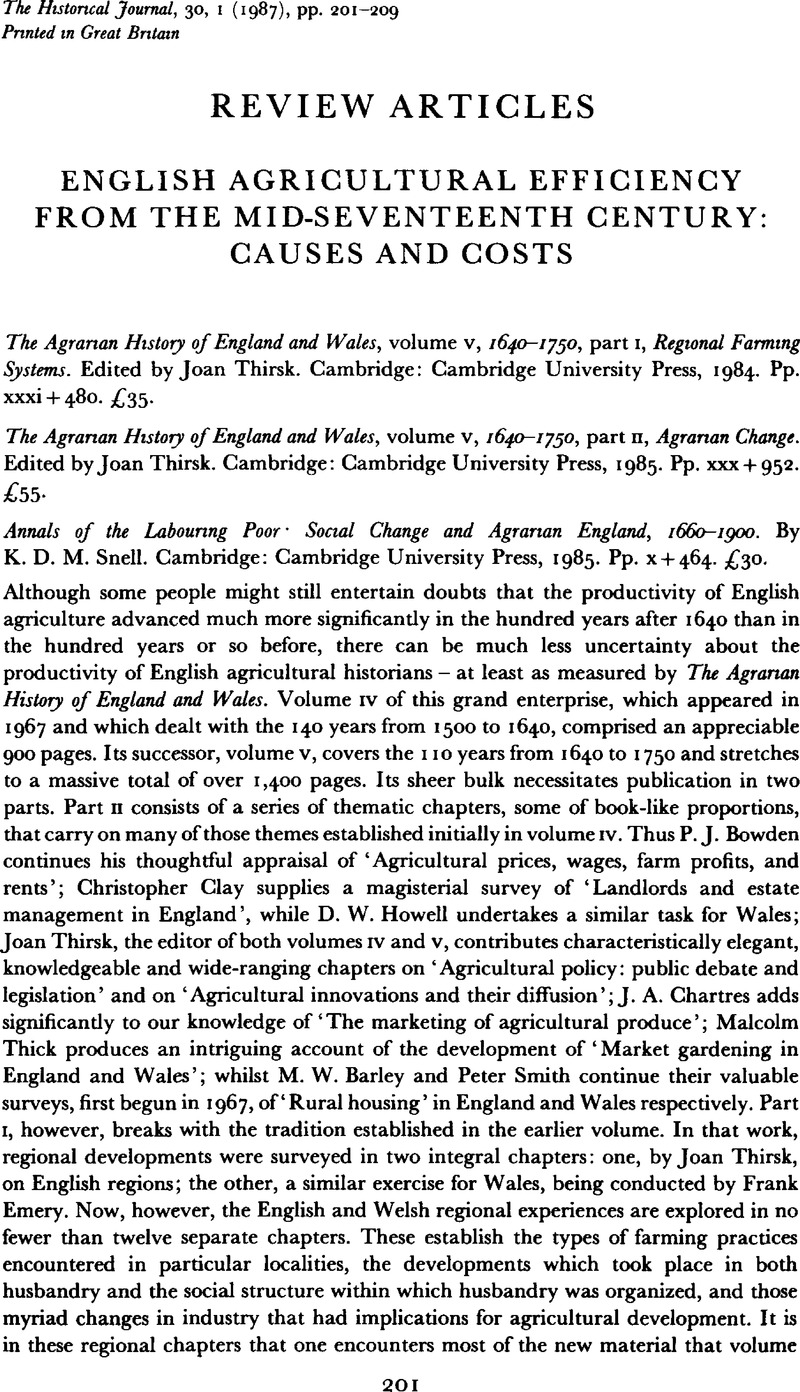No CrossRef data available.
Published online by Cambridge University Press: 11 February 2009

1 Wrigley, E. A., ‘Urban growth and agricultural change: England and the Continent in the early modern period’, Journal of Interdisciplinary History, XV, 4 (1985), 683–728CrossRefGoogle Scholar.
2 Wrigley, table 4, p. 700.
3 Many of the arguments outlined in Jones, E. L., ‘Agricultural origins of industry’, Past and Present, XL (1968), 58–71CrossRefGoogle Scholar, are substantiated by the important accounts of industrial development in various regions to be found in part 1 of the new Agrarian History (hereafter AH).
4 Jackson, R. V., ‘Growth and deceleration in English agriculture, 1660–1790’, Economic History Review, second series, XXXVIII, 30 (1985), 333–51Google Scholar.
5 Jackson, p. 349.
6 Outhwaite, R. B., ‘Progress and backwardness in English agriculture, 1500–1650’, Economic History Review, second series, XXXIX, 1 (1986), 1–18CrossRefGoogle Scholar.
7 Wrigley, E A and Schofield, R S, The population history of England 1541 1871 (London, 1981)Google Scholar
8 Bowden, , AH, II, 1–12Google Scholar
9 Especially if the 31 4 per cent increase in the price of hops is also taken into account
10 Compare the arguments adduced for advances in the later middle ages in Outhwaite, pp. 5–7.
11 Bowden, , AH, 11, 7–8Google Scholar.
12 Thirsk, , AH, 11, 570, 586Google Scholar.
13 Chartres, , AH, 11, 442–4Google Scholar.
14 Holderness, , AH, 1, 218–9Google Scholar.
15 Wordie, , AH, 1, 321, 324, 328, 336–7Google Scholar.
16 Thirsk, , AH, 1, 179Google Scholar.
17 Richardson, , AH, 1, 243Google Scholar.
18 Hey, , AH, 1, 138, 142, 146, 151–4, 157–8Google Scholar.
19 Thirsk, , AH, 1, 164, 166, 172, 179Google Scholar.
20 Holderness, , AH, 1, 236Google Scholar.
21 Wordie, , AH, 1, 336Google Scholar.
22 Harrison, , AH, 1, 388Google Scholar.
23 Yelling, J. A., Common field and enclosure in England, 1450–1850 (London, 1977), pp. 156–9, 183–6CrossRefGoogle Scholar. It might have been useful, for example, in deciding the outcome in Sherwood Forest, where cattle numbers tended to rise but sheep numbers fell (AH, 1, 110).
24 This evidence is scattered throughout the Agrarian History, but on lime see also Havinden, M. A., ‘Lime as a means of agricultural improvement: the Devon example’, in Chalklin, C. W. and Havinden, M. A. (eds.), Rural change and urban growth, 1500–1800 (London, 1974), pp. 104–34Google Scholar.
25 Bowden, , AH, 11, 9Google Scholar.
26 Cited in Clay, , AH, 11, 232Google Scholar. I have extended the abbreviations in the passage cited here.
27 Short, , AH, 1, 292Google Scholar.
28 Cf. the explanation of marriage behaviour, fertility, and real-wage trends in Wrigley and Schofield, pp. 417–35.
29 Snell, p. 185.
30 Thirsk, , AH, 11, 578Google Scholar.
31 Overton, M., ‘The diffusion of agricultural innovations in early modern England: turnips and clover in Norfolk and Suffolk, 1580–1740’, Transactions of the Institute of British Geographers, new series, X (1985), 205–21CrossRefGoogle Scholar.